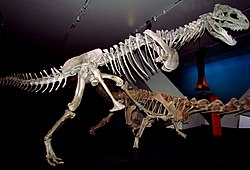Majungasaurinae
| Majungasaurines Temporal range: Late Cretaceous, 76–66 Ma |
|
|---|---|
 |
|
| Display of Majungasaurus crenatissimus at the Royal Ontario Museum | |
| Scientific classification | |
| Kingdom: | Animalia |
| Phylum: | Chordata |
| Class: | Reptilia |
| Clade: | Dinosauria |
| Order: | Saurischia |
| Suborder: | Theropoda |
| Family: | †Abelisauridae |
| Subfamily: |
†Majungasaurinae Tortosa et al., 2013 |
| Type species | |
|
†Majungasaurus crenatissimus (Depéret, 1896 [originally Megalosaurus]) Lavocat, 1955 |
|
Majungasaurinae (named after the city of Mahajanga in Madagascar) is a subfamily of large carnivorous theropods from the Upper Cretaceous, found in Madagascar, India, and France. It is a subgroup within the theropod family Abelisauridae, a Gondwanan clade known for their thick and often horned skulls and vestigial arms. The two subfamilies of Abelisauridae are Carnotaurinae, best known from the South American Carnotaurus, and Majungasaurinae, consisting of Madagascar’s Majungasaurus and its closest relatives. Their ancestors emerged in the Middle Jurassic, and the clade lasted until the Upper Cretaceous.
The majungasaurines were mid-sized, bipedal predators, but relatively slow moving. Their long legs were built for striding, not running. They had tall, deep heads with powerful jaws, but small forearms without carpels in the wrists. Because of their slow gait and small arms, they likely preyed upon the larger, slower sauropods rather than the smaller, faster ornithopods. Their ancestors lived on a unified southern continent, Gondwana, in the Early Cretaceous, but as the land mass divided they became distinct from their South American cousins, and eventually from each other.
The abelisaurids all possess distinct, vestigial, and immobile forelimbs, with highly reduced manual phalanges.Carnotaurus and Majungasaurus are closely related but distinguish by several skeletal features. Carnotaurus has eleven dorsal vertebrae but Majungasaurus has thirteen.Carnotaurus has short dentary bones and an almost vertical ramus, while that of Majungasaurus curved backward and had notable caudal projections. Majungasaurines also have low, wide antorbital fenestrae, a wide triangular plate posterior to the parietal, two holes for a cerebral vein by the sagittal crest, and a wide groove on the occipital condyle. These differences are important because derived abelisaurids are classed as either majungasaurines or carnotaurines based on their synapomorphies.
...
Wikipedia
